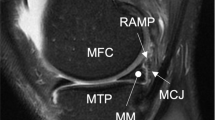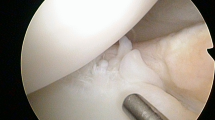Abstract
Purpose
The purpose of this study was to evaluate the clinical outcomes of various methods of treatment of stable and unstable ramp lesions compared to patients with no meniscal pathology at the time of primary ACL reconstruction.
Methods
All patients with a preoperative MRI performed at our facility who were enrolled in an institutional ACL registry and 1-year clinical follow-up were identified. A musculoskeletal radiologist reviewed preoperative MRI scans for evidence of a ramp lesion. Ramp lesions were classified as stable if a peripheral tear of the posterior horn of the medial meniscus was identified by MRI, but did not displace into the medial compartment with anteriorly directed probing at the time of surgery. Ramp lesions were classified as unstable if a tear was identified by preoperative MRI at the meniscocapsular junction and the meniscus was displaceable into the medial compartment with probing. Reoperation rates for ACL graft failure or recurrent medial meniscus pathology were collected. Patient-reported outcome scores (IKDC, SF12 PCS, SF12 MCS, and Marx Activity scale) were recorded at baseline and final follow-up.
Results
A total of 162 patients were included in the analysis with median 2-year (range 1–5 years) clinical follow-up. Patients with a repaired unstable ramp lesion had a significantly higher likelihood of reoperation for recurrent medial meniscus pathology than patients without meniscal pathology at the time of index surgery. Patients with an untreated stable ramp lesion had a similar rate of reoperation when compared to patients without meniscal pathology. At final follow-up, there was no difference between groups in IKDC score, SF12 PCS/MCS, or Marx activity score or change in any score.
Conclusions
Patients with untreated stable ramp lesions have similar clinical outcomes at median 2-year (range 1–5 years) follow-up when compared to patients without a ramp lesion. Treatment of stable ramp lesions at the time of ACL reconstruction does not have clinical benefit.
Level of evidence
III.




Similar content being viewed by others
References
Arner JW, Herbst E, Burnham JM, Soni A, Naendrup JH, Popchak A et al (2017) MRI can accurately detect meniscal ramp lesions of the knee. Knee Surg Sports Traumatol Arthrosc 25(12):3955–3960
Bollen SR (2010) Posteromedial meniscocapsular injury associated with rupture of the anterior cruciate ligament: a previously unrecognised association. J Bone Joint Surg Br 92:222–223
Bumberger A, Koller U, Hofbauer M, Tiefenboeck TM, Hajdu S, Windhager R et al (2020) Ramp lesions are frequently missed in ACL-deficient knees and should be repaired in case of instability. Knee Surg Sports Traumatol Arthrosc 28:840–854
Chahla J, Dean CS, Moatshe G, Mitchell JJ, Cram TR, Yacuzzi C et al (2016) Meniscal ramp lesions: anatomy, incidence, diagnosis, and treatment. Orthop J Sports Med 4:2325967116657815
Cooper DE, Arnoczky SP, Warren RF (1990) Arthroscopic meniscal repair. Clin Sports Med 9:589–607
DePhillipo NN, Cinque ME, Chahla J, Geeslin AG, Engebretsen L, LaPrade RF (2017) Incidence and detection of meniscal ramp lesions on magnetic resonance imaging in patients with anterior cruciate ligament reconstruction. Am J Sports Med 45:2233–2237
DePhillipo NN, Engebretsen L, LaPrade RF (2019) Current trends among US surgeons in the identification, treatment, and time of repair for medial meniscal ramp lesions at the time of ACL surgery. Orthop J Sports Med 7:2325967119827267
Hetsroni I, Lillemoe K, Marx RG (2011) Small medial meniscocapsular separations: a potential cause of chronic medial-side knee pain. Arthroscopy 27:1536–1542
Keyhani S, Ahn JH, Verdonk R, Soleymanha M, Abbasian M (2017) Arthroscopic all-inside ramp lesion repair using the posterolateral transseptal portal view. Knee Surg Sports Traumatol Arthrosc 25:454–458
Kim SH, Lee SH, Kim KI, Yang JW (2018) Diagnostic accuracy of sequential arthroscopic approach for ramp lesions of the posterior horn of the medial meniscus in anterior cruciate ligament-deficient knee. Arthroscopy 34:1582–1589
Li WP, Chen Z, Song B, Yang R, Tan W (2015) The FasT-Fix repair technique for ramp lesion of the medial meniscus. Knee Surg Relat Res 27:56–60
Liu X, Feng H, Zhang H, Hong L, Wang XS, Zhang J (2011) Arthroscopic prevalence of ramp lesion in 868 patients with anterior cruciate ligament injury. Am J Sports Med 39:832–837
Liu X, Zhang H, Feng H, Hong L, Wang XS, Song GY (2017) Is it necessary to repair stable ramp lesions of the medial meniscus during anterior cruciate ligament reconstruction? A prospective randomized controlled trial. Am J Sports Med 45:1004–1011
Malatray M, Raux S, Peltier A, Pfirrmann C, Seil R, Chotel F (2017) Ramp lesions in ACL deficient knees in children and adolescent population: a high prevalence confirmed in intercondylar and posteromedial exploration. Knee Surg Sports Traumatol Arthrosc 26(4):1074–1079
McCarthy M, Mallett K, Abola M, Vassallo S, Nguyen J (2017) Hospital for special surgery ACL registry: 2-year outcomes suggest low revision and return to OR rates. HSS J 13:119–127
Mouton C, Magosch A, Pape D, Hoffmann A, Nuhrenborger C, Seil R (2019) Ramp lesions of the medial meniscus are associated with a higher grade of dynamic rotatory laxity in ACL-injured patients in comparison to patients with an isolated injury. Knee Surg Sports Traumatol Arthrosc. https://doi.org/10.1007/s00167-019-05579-z
Nwachukwu BU, Chang B, Voleti PB, Berkanish P, Cohn MR, Altchek DW et al (2017) Preoperative short form health survey score is predictive of return to play and minimal clinically important difference at a minimum 2-year follow-up after anterior cruciate ligament reconstruction. Am J Sports Med 45:2784–2790
Peltier A, Lording T, Maubisson L, Ballis R, Neyret P, Lustig S (2015) The role of the meniscotibial ligament in posteromedial rotational knee stability. Knee Surg Sports Traumatol Arthrosc 23:2967–2973
Sonnery-Cottet B, Conteduca J, Thaunat M, Gunepin FX, Seil R (2014) Hidden lesions of the posterior horn of the medial meniscus: a systematic arthroscopic exploration of the concealed portion of the knee. Am J Sports Med 42:921–926
Stephen JM, Halewood C, Kittl C, Bollen SR, Williams A, Amis AA (2016) Posteromedial meniscocapsular lesions increase tibiofemoral joint laxity with anterior cruciate ligament deficiency, and their repair reduces laxity. Am J Sports Med 44:400–408
Strobel M (2002) Manual of arthroscopic surgery. Springer, New York
Thaunat M, Fayard JM, Guimaraes TM, Jan N, Murphy CG, Sonnery-Cottet B (2016) Classification and surgical repair of ramp lesions of the medial meniscus. Arthrosc Tech 5:e871–e875
Thaunat M, Jan N, Fayard JM, Kajetanek C, Murphy CG, Pupim B et al (2016) Repair of meniscal ramp lesions through a posteromedial portal during anterior cruciate ligament reconstruction: outcome study with a minimum 2-year follow-up. Arthroscopy 32:2269–2277
Yang J, Guan K, Wang JZ (2017) Clinical study on the arthroscopic refreshing treatment of anterior cruciate ligament injury combined with stable medial meniscus ramp injury. J Musculoskelet Neuronal Interact 17:108–113
Author information
Authors and Affiliations
Corresponding author
Ethics declarations
Conflict of Interest
GCB, HGG, NM, and DW report that they have no conflicts of interest in the authorship and publication of this article. SAR declares that he has received royalties from Zimmer Biomet, has stock options from Ortho RTI, and has served as a consultant to Advance Medical. RGM declares that he has received royalties from Springer and Demos Health, and has received equity compensation from MEND Nutrition. HGG declares that she has received research support from GE Healthcare and GE/NBA, has served as a consultant to Ortho RTI and Smith & Nephew, and owns stock or stock options in Imagen. RJW declares that he has received research support from Histogenics Inc, royalties from Arthrex, has served as a consultant to JRF Ortho, and owns stock or stock options in Cymedica, Gramercy Extremity Orthopedics, Pristine Surgical, and RecoverX.
Funding
No funding was received in support of this project.
Ethical approval
Ethical approval was granted by the Hospital for Special Surgery Institutional Review Board.
Additional information
Publisher's Note
Springer Nature remains neutral with regard to jurisdictional claims in published maps and institutional affiliations.
Investigation performed at Hospital for Special Surgery, New York, NY.
Rights and permissions
About this article
Cite this article
Balazs, G.C., Greditzer, H.G., Wang, D. et al. Non-treatment of stable ramp lesions does not degrade clinical outcomes in the setting of primary ACL reconstruction. Knee Surg Sports Traumatol Arthrosc 28, 3576–3586 (2020). https://doi.org/10.1007/s00167-020-06017-1
Received:
Accepted:
Published:
Issue Date:
DOI: https://doi.org/10.1007/s00167-020-06017-1




